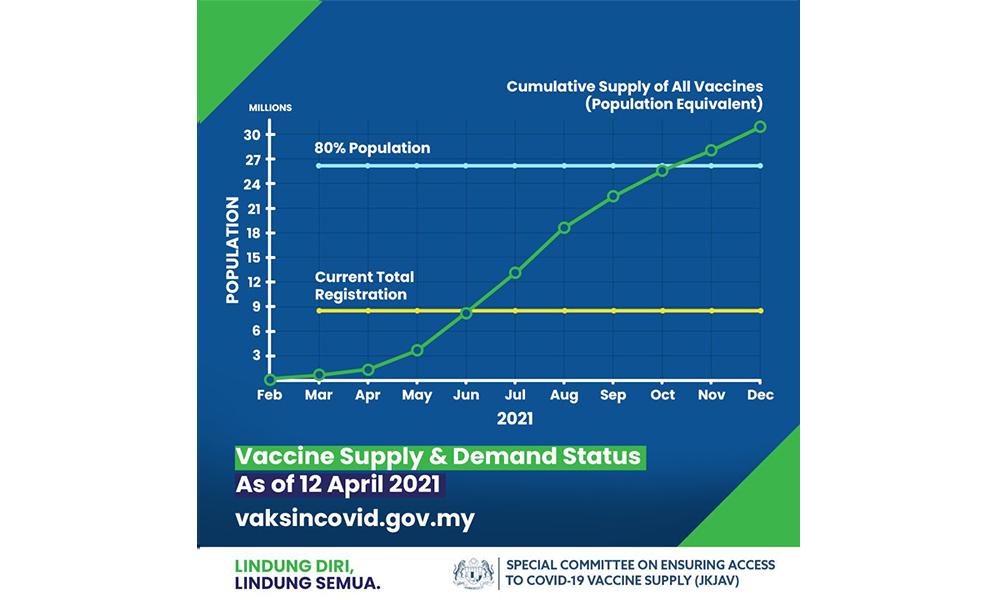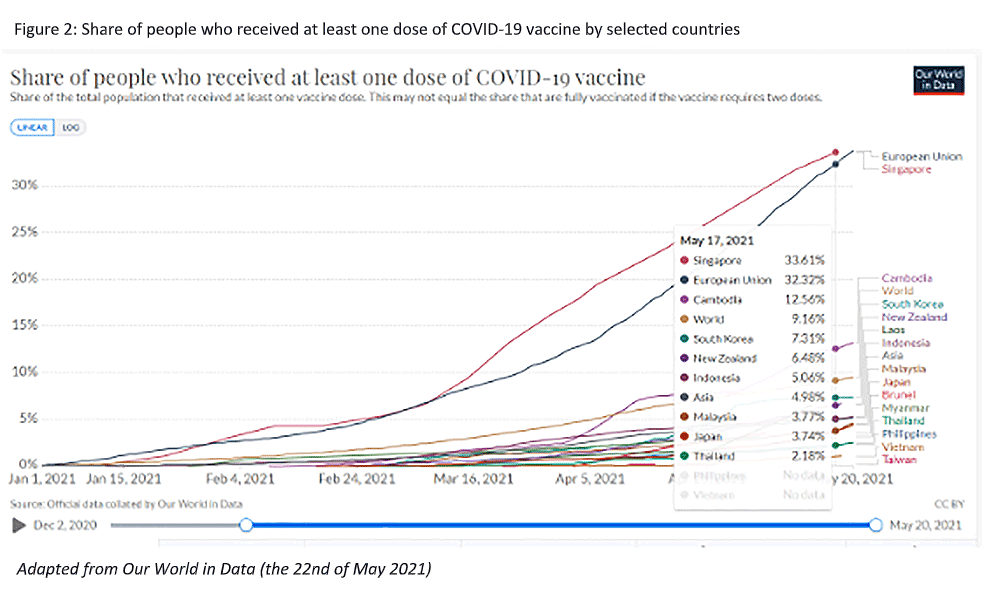LETTER | The National Covid-19 Immunisation Programme (NIP) kick-started with a lot of fanfare. Prime Minister Muhyiddin Yassin received his first vaccine in public on February 24. Three months later, the people expressed their dissatisfaction and lamented that the vaccination rate is too low, alleging that it is mainly due to the government being slow and incompetent. Often, the “better” countries they cited are Singapore, European Union countries, the United States, Israel and so on. I would like to offer an objective perspective on the national vaccination programme.
Often the public judges a policy or a programme by its immediate outcome. In this case, the current number and percentage of people vaccinated or have received at least one dose of vaccine. However, one must first consider the NIP process in its entirety to understand the outcome, including the procurement, registration and delivery of the vaccines, the registration of participants, and finally, the administration of the vaccines.
We should understand that the government has allocated funds to procure 66.7 million doses covering 109.65 percent of residents in the country from 5 sources: Pfizer, AstraZeneca, Sinovac, CanSino and Gamaleya/RIDF (Sputnik V). Currently, the first three have obtained product registration approval from the National Pharmaceutical Regulatory Agency (NPRA) that is responsible for ensuring the safety, efficacy and quality of all pharmaceutical products before they can be used in Malaysia. The government has set the target timeline to vaccinate at least 80 percent of the population by February 2022.
Undoubtedly, the current vaccination rate is not as fast as many expect to see, especially during the recent wave of severe infection sweeping across the country. As of May 20, the percentage of vaccinated persons (who received two doses) and those who received at least one dose is 2.6 percent and 4.2 percent, respectively. Based on the current vaccination rate, one projection shows that Malaysia would need about five years to vaccinate 80 percent of its population. Is that a fair assessment of the situation?

On April 12, the special committee on ensuring access to Covid-19 vaccine supply (JKJAV) published the timeline of vaccine supply (Figure 1). If we take a look at the vaccine supply (green trend line), compared to current demand by registration counts (yellow horizontal line) and the target vaccination coverage (light blue line), it is clear that we were facing a vaccine shortage at the early stage. The same scenario is happening to many countries globally.

Malaysia is not too far from the average Asian countries and even ahead of Japan and Thailand (see Figure 2). When some vaccine manufacturing countries declare bans or restrictions on vaccine exports, like India and the European Union, these will disrupt the scheduled supply to many countries. Prior to the pandemic, Malaysia did not have vaccine manufacturing ability except for Duopharma’s fill-and-finish facility. Since then Pharmaniaga has set up its fill-and-finish capacity. While the two GLCs are tasked to do this last manufacturing step for Sputnik V and Sinovac vaccines respectively thus lowering costs, they still need to import the bulk inputs from China and Russia. It is pointless to talk about faster vaccination rates when the local manufacturers cannot guarantee to deliver the vaccines as planned. The demand for such precious resources is tremendous, and the production is insufficient. It is not that the government lacks resources to set up vaccination centres to speed up vaccine administration; that would require just two to three days to do so.
Meanwhile, the registration rate for vaccination in Malaysia is still not satisfactory. As of the 20th of May, only 43 percent of eligible 18 years and above of the population have registered. That means that even if the federal government were to receive all of the vaccine orders today, there would be more than half of those doses with no takers.
Apart from the less than satisfactory registration, it is also not difficult to understand why the public harbours the sentiment that the vaccination programme is going too slow. The current percentage of those who received at least one dose of the vaccine among the registered population is 13.3 percent, which means 86.7 percent of people are still in the waiting queue. We can understand that they get frustrated with the current pandemic situation.

The states/federal territories with more than 50 percent of its population registered for the vaccination programme are Putrajaya, Kuala Lumpur, Selangor, Sarawak, Labuan and Penang (see Figure 3). But if one looks at the percentage of registered participants who received at least one dose of the vaccine - states like Selangor, Johor, Penang and Sarawak fall below the national average. However, these states have received the most compared to other less populated states in terms of the actual number of administered doses.
This might explain why certain states feel like they need to take matters into their own hands to “speed up” the vaccination campaign. On the 16th of May, the Sarawak state government announced that they had procured one million doses of the Sinovac vaccine, expected to arrive soon in two batches.
On May 18, the NIP coordinating minister, Khairy Jamaluddin, clarified the conditions under which the state governments are allowed to procure their vaccine supplies. A day after the minister’s statement, the Selangor state government announced its own Selgate Covid-19 Vaccination Programme. This programme aims to register employers in Selangor to vaccinate their employees with the Sinovac vaccine for RM190 per dose. On the same day, the Penang Chief Minister Chow Kon Yeow and former finance minister Lim Guan Eng famously criticised the federal government in a press conference for blocking a private donor from contributing two million doses of Sinovac vaccine to the Penang state government.
The conditions clarified by Khairy were clear. Firstly, the products must be registered and approved by the NPRA that checks the vaccines’ efficacy and safety profile according to laws and regulations that are based on stringent standards of the WHO and OECD countries. Secondly, if the procurement source is from the same pharmaceutical company as the NIP, the federal government will be prioritised to receive its supplies before any other parties from Malaysia. This was an agreement with the vaccine manufacturers to ensure that the national vaccination programme is not compromised. Thirdly, if the supplier is not involved in the NIP - the state governments or private sector can freely procure them provided they have received an approval by the NPRA for the vaccines concerned.
Therefore, the apparent win-win situation is when a state government secures alternative vaccine sources outside the NIP vaccine portfolio. However, based on what we saw in the past week - the three state governments are considering the Sinovac vaccine. They are going for the same vaccine pool, therefore directly competing with the federal government! Suppose these states receive the vaccines before the federal government’s remaining order - it will come at the expense of other states that do not have the financial resources or wealthy donors to access the vaccine quickly.
Setting this precedent will open Pandora’s Box. Other state governments may follow suit to demonstrate to their voters that they can also get ahead of the queue. It will result in something that we must avoid: the politicisation of the NIP. Imagine if states go their own way - eventually, this could create a chaotic situation for the NIP and probably undermine the national programme. What is worse, this could erode the social solidarity and the consensus to allow citizens and residents with health vulnerabilities (and thus carry a higher risk of Covid-19) to receive the vaccines first.
One should not only think about vaccine procurement but also consider the logistics and execution of vaccination. Who administers the vaccines? The NIP currently involves private healthcare facilities to help with the public vaccination programme. Would the state governments also compete with the federal government over the human resources required for vaccine administration? If this affects the national programme, at whose expense will it be? The NIP is free of charge at the point of vaccine administration; this is different, for example, from Selangor’s proposed programme. As the latter signals that those employers who can pay can get the vaccine first, what does it say about the social solidarity over vaccination priorities?
At the height of the current pandemic, we should be wary of opportunistic political upmanship that feeds on public frustration (often due to misinformation) and desperation for faster vaccination. Instead, we should call for patience and a better understanding of the process and issues related to the NIP. Most importantly, people should stand in solidarity to fight the pandemic together, not just thinking for oneself first but also for every one of us.
DR LIM CHEE HAN is a public health policy researcher, currently senior researcher at Third World Network and co-convener of the People’s Health Forum Malaysia.
The views expressed here are those of the author/contributor and do not necessarily represent the views of Malaysiakini.

